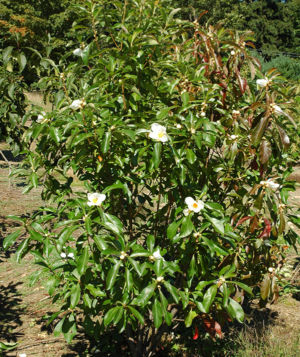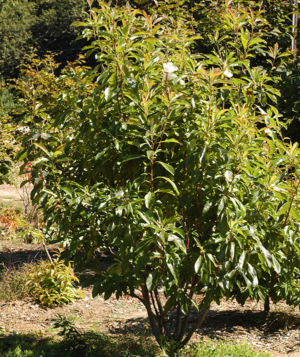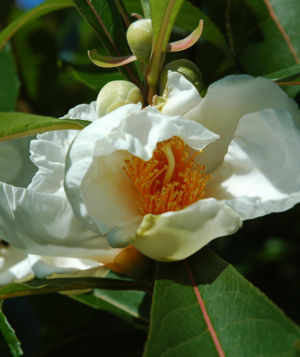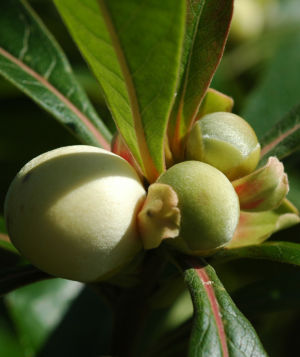Franklin Tree – Franklinia alatamaha
Description
General: A small, multi-branched tree reaching 15′-20′ in height with comparable width. It was discovered in 1765 by plant explorers, John and William Bartram, on the Alatamaha River in Georgia. They named it after their good friend, Benjamin Franklin. It is in the same taxonomical family as Camellia and Stewartia.
Leaves: Bright green with a glossy sheen, serrate leaf margin, oblong, 4″-8″ in length. Autumn foliage is showy turning crimson if in a sunny location.
Flowers: Creamy white spherical buds held tightly against the stems open to reveal 3″-3.5″ white, cupped shaped flowers with yellow/orange centers that are slightly fragrant. They are in full bloom mid to late September at Great Hill following Stewartia.
Fruit: Woody, opening in a star shape to release the seeds in the fall following blooming.
Bark: Smooth gray bark with vertical white stripes giving the tree winter interest.
Attributes: This is a valuable specimen tree for any landscape as its size permits its use in even small urban settings. It will provide four seasons of interest and flowers late in the season when most other trees are not.
Culture
Hardiness: Zones 5- 8
Growing Conditions: Full sun to partial sun location, prefers well-drained, rich, acidic soil. The fall foliage and quantity of flowers are more spectacular if it receives full sun.
Maintenance: Franklinia needs adequate water in the summer, as well as through the fall and likes to be protected from strong winds. Minimal pruning is required to retain shape. No insect or disease problems to note.
Transplanting: Balled and burlapped spring or mid to late fall as a young tree.
Our Experience
Experience at Great Hill
Following harsh winters, some stem die back may occur, but the tree puts on a lot of new growth to overcome this. This may contribute to its multi-stemmed, shrub-like growth habit here at Great Hill. We have noticed that growth is better during years of greater precipitation. It leafs out late compared to other trees and also holds its leaves late into the fall.
Historical Winter Data:
2018:





